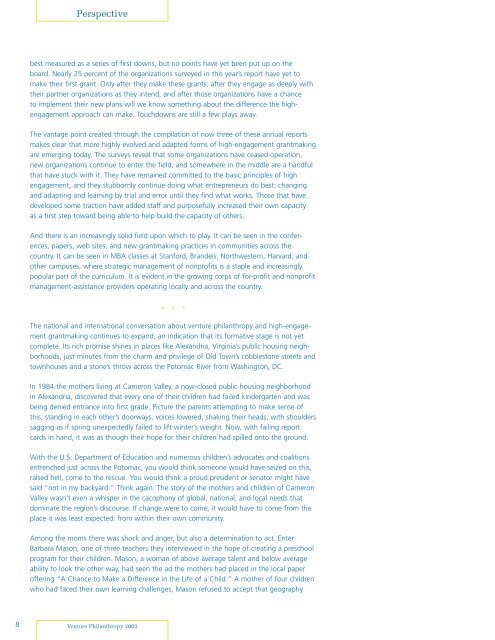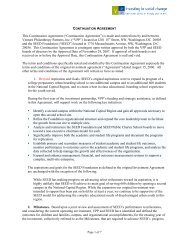Introduction, Essays on High-Engagement Grantmaking - Venture ...
Introduction, Essays on High-Engagement Grantmaking - Venture ...
Introduction, Essays on High-Engagement Grantmaking - Venture ...
Create successful ePaper yourself
Turn your PDF publications into a flip-book with our unique Google optimized e-Paper software.
Perspective<br />
best measured as a series of first downs, but no points have yet been put up <strong>on</strong> the<br />
board. Nearly 25 percent of the organizati<strong>on</strong>s surveyed in this year’s report have yet to<br />
make their first grant. Only after they make these grants, after they engage as deeply with<br />
their partner organizati<strong>on</strong>s as they intend, and after those organizati<strong>on</strong>s have a chance<br />
to implement their new plans will we know something about the difference the highengagement<br />
approach can make. Touchdowns are still a few plays away.<br />
The vantage point created through the compilati<strong>on</strong> of now three of these annual reports<br />
makes clear that more highly evolved and adapted forms of high-engagement grantmaking<br />
are emerging today. The surveys reveal that some organizati<strong>on</strong>s have ceased operati<strong>on</strong>,<br />
new organizati<strong>on</strong>s c<strong>on</strong>tinue to enter the field, and somewhere in the middle are a handful<br />
that have stuck with it. They have remained committed to the basic principles of high<br />
engagement, and they stubbornly c<strong>on</strong>tinue doing what entrepreneurs do best: changing<br />
and adapting and learning by trial and error until they find what works. Those that have<br />
developed some tracti<strong>on</strong> have added staff and purposefully increased their own capacity<br />
as a first step toward being able to help build the capacity of others.<br />
And there is an increasingly solid field up<strong>on</strong> which to play. It can be seen in the c<strong>on</strong>ferences,<br />
papers, web sites, and new grantmaking practices in communities across the<br />
country. It can be seen in MBA classes at Stanford, Brandeis, Northwestern, Harvard, and<br />
other campuses, where strategic management of n<strong>on</strong>profits is a staple and increasingly<br />
popular part of the curriculum. It is evident in the growing corps of for-profit and n<strong>on</strong>profit<br />
management-assistance providers operating locally and across the country.<br />
* * *<br />
The nati<strong>on</strong>al and internati<strong>on</strong>al c<strong>on</strong>versati<strong>on</strong> about venture philanthropy and high-engagement<br />
grantmaking c<strong>on</strong>tinues to expand, an indicati<strong>on</strong> that its formative stage is not yet<br />
complete. Its rich promise shines in places like Alexandria, Virginia’s public housing neighborhoods,<br />
just minutes from the charm and privilege of Old Town’s cobblest<strong>on</strong>e streets and<br />
townhouses and a st<strong>on</strong>e’s throw across the Potomac River from Washingt<strong>on</strong>, DC.<br />
In 1984 the mothers living at Camer<strong>on</strong> Valley, a now-closed public housing neighborhood<br />
in Alexandria, discovered that every <strong>on</strong>e of their children had failed kindergarten and was<br />
being denied entrance into first grade. Picture the parents attempting to make sense of<br />
this, standing in each other’s doorways, voices lowered, shaking their heads, with shoulders<br />
sagging as if spring unexpectedly failed to lift winter’s weight. Now, with failing report<br />
cards in hand, it was as though their hope for their children had spilled <strong>on</strong>to the ground.<br />
With the U.S. Department of Educati<strong>on</strong> and numerous children’s advocates and coaliti<strong>on</strong>s<br />
entrenched just across the Potomac, you would think some<strong>on</strong>e would have seized <strong>on</strong> this,<br />
raised hell, come to the rescue. You would think a proud president or senator might have<br />
said “not in my backyard.” Think again. The story of the mothers and children of Camer<strong>on</strong><br />
Valley wasn’t even a whisper in the cacoph<strong>on</strong>y of global, nati<strong>on</strong>al, and local needs that<br />
dominate the regi<strong>on</strong>’s discourse. If change were to come, it would have to come from the<br />
place it was least expected: from within their own community.<br />
Am<strong>on</strong>g the moms there was shock and anger, but also a determinati<strong>on</strong> to act. Enter<br />
Barbara Mas<strong>on</strong>, <strong>on</strong>e of three teachers they interviewed in the hope of creating a preschool<br />
program for their children. Mas<strong>on</strong>, a woman of above average talent and below average<br />
ability to look the other way, had seen the ad the mothers had placed in the local paper<br />
offering “A Chance to Make a Difference in the Life of a Child.” A mother of four children<br />
who had faced their own learning challenges, Mas<strong>on</strong> refused to accept that geography<br />
8 <strong>Venture</strong> Philanthropy 2002






